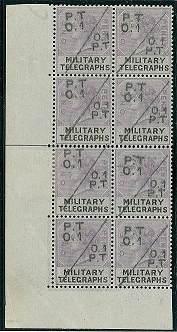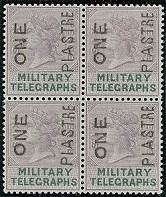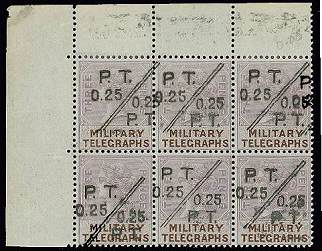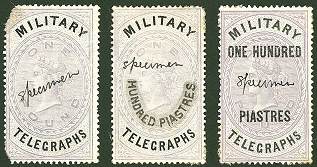
Has my last message arrived or not? Please reply about the result.
| “The immediate cause of the issue of these stamps… was the inconvenience caused to the officials in charge of the Army Telegraphs in Egypt, through having to keep account of small amounts paid in currency. With a view to obviate this inconvenience, Colonel Webber, C.B., of the Royal Engineers, personally applied, in the autumn of 1884, to the Controller of Stamps at Somerset House, for a series of stamps from the ‘unappropriated dies,’ overprinted ‘Military Telegraphs’… They were received about the middle of September, 1884, and presumably issued at once.” 1 |
 Langmead and Huggins 5 report: “An office was established in Cairo as the terminus for the army wire with intermediate stations at Assiut, Assuan, Korosco, [and]
Wadi Halfa, in Upper Egypt. South of Halfa was the area of the Sudan telegraphs under the control of the army…”. On 1st May 1885 the operations of the telegraph
system in Upper Egypt was transferred to military control 6. This would seem to imply that there would have been an even greater need for these telegraph stamps.
Indeed, “De La Rue record the overprinting of 499 sheets of the 1s in February 1886, which were presumably sent to Cairo.” 7 However, the survival rate of used stamps
is very low. With used telegraph stamps, the survival rate is often a function of the level of security surrounding the destruction of the used telegraph transmission
forms. In Egypt it does seem that most used forms and stamps were conscientiously destroyed.
Langmead and Huggins 5 report: “An office was established in Cairo as the terminus for the army wire with intermediate stations at Assiut, Assuan, Korosco, [and]
Wadi Halfa, in Upper Egypt. South of Halfa was the area of the Sudan telegraphs under the control of the army…”. On 1st May 1885 the operations of the telegraph
system in Upper Egypt was transferred to military control 6. This would seem to imply that there would have been an even greater need for these telegraph stamps.
Indeed, “De La Rue record the overprinting of 499 sheets of the 1s in February 1886, which were presumably sent to Cairo.” 7 However, the survival rate of used stamps
is very low. With used telegraph stamps, the survival rate is often a function of the level of security surrounding the destruction of the used telegraph transmission
forms. In Egypt it does seem that most used forms and stamps were conscientiously destroyed. The Langmead telegraph collection contained a presentation sheet bearing a set of the “Military Telegraphs” stamps (cancelled with a metal “ARMY TELEGRAPHS/ CAIRO”
datestamp set at “9 MAI 86”)8 Illustrated left Fig.1. This sheet also provided evidence that the 1d value could be bisected to be used as two ½d values.
Apart from
this sheet, the Langmead collection contained only one 1d stamp showing part of a datestamp reading “ARMY TEL”. As the location was not shown, this was described in
the auction catalogue as bearing “the same 33.5mm. double ring c.d.s. (dated Mar. 25) employed on the presentation sheet, although no stamps definitely known
telegraphically used in Egypt have so far been recorded.”9 Now, thanks to the wonders of the internet, it is possible to report the discovery of a 10/- stamp
with more of the datestamp and crucially showing the word “[C]AIRO”, thus indicating that at least some of these stamps escaped destruction. These two stamps are
shown in right. Fig.2
The Langmead telegraph collection contained a presentation sheet bearing a set of the “Military Telegraphs” stamps (cancelled with a metal “ARMY TELEGRAPHS/ CAIRO”
datestamp set at “9 MAI 86”)8 Illustrated left Fig.1. This sheet also provided evidence that the 1d value could be bisected to be used as two ½d values.
Apart from
this sheet, the Langmead collection contained only one 1d stamp showing part of a datestamp reading “ARMY TEL”. As the location was not shown, this was described in
the auction catalogue as bearing “the same 33.5mm. double ring c.d.s. (dated Mar. 25) employed on the presentation sheet, although no stamps definitely known
telegraphically used in Egypt have so far been recorded.”9 Now, thanks to the wonders of the internet, it is possible to report the discovery of a 10/- stamp
with more of the datestamp and crucially showing the word “[C]AIRO”, thus indicating that at least some of these stamps escaped destruction. These two stamps are
shown in right. Fig.2 |
| Fig 3 |
| From Zobaidah Ali from Almotiah in Jadidah
To Council of Egyptian Decisions Has my last message arrived or not? Please reply about the result. |
| “It would appear that in 1886, the Director of Army Telegraphs in Egypt found that considerable difficulty was experienced, in maintaining equation between the telegraph charges in Egyptian currency, and the telegraph stamps with value in English money: and this difficulty was further increased by the depreciation of English silver which took place about this time. To remedy this, the entire stock of these [Military Telegraphs] stamps then in Egypt was surcharged with arbitrary piastre values… The extreme dryness of the African climate naturally caused the sheets of stamps to curl up; and that to such an extent, as to make it impossible to surcharge entire sheets at once… The stupendous task of surcharging each stamp separately was resolved upon, and was, in July, 1886, carried out by means of a self-inking revolving [hand]stamp.”13 |
The values attributed to the original issue were as follows: “0.1 P.T” (x2) on 1d, “0.25 P.T.” (x2) on 3d, “ONE PIASTRE” on 6d, “FIVE PIASTRES” on 1/-,
“TEN PIASTRES” on 2/-, “TWENTY FIVE PIASTRE” on 5/-, “FIFTY PIASTRES” on 10/- and a “HUNDRED PIASTRES” on £1. It is not known how many stamps were so treated.
“This issue was in use from July, 1886, to the end of the following February. The unused remainders were subsequently brought back to England and destroyed.”
14
   The significance of this “self-inking revolving [hand]stamp” does not seem to have been discussed in previous articles. The implications of this statement can be
seen when blocks of these stamps are examined, but because individual stamps are very scarce, blocks are rarely encountered. The author is of the opinion that when
blocks are examined, it seems there are variations in the surcharge from one stamp to another. This it would appear is because, as stated above, the handstamp
revolved as it self-inked and that it seems it had more than one face and so slight variations in the surcharges can be identified on stamps of the same value
(see Figure 4). The number of faces on the handstamp is not known.
The significance of this “self-inking revolving [hand]stamp” does not seem to have been discussed in previous articles. The implications of this statement can be
seen when blocks of these stamps are examined, but because individual stamps are very scarce, blocks are rarely encountered. The author is of the opinion that when
blocks are examined, it seems there are variations in the surcharge from one stamp to another. This it would appear is because, as stated above, the handstamp
revolved as it self-inked and that it seems it had more than one face and so slight variations in the surcharges can be identified on stamps of the same value
(see Figure 4). The number of faces on the handstamp is not known. |
 At least three sets of the handstamped surcharged stamps exist bearing the word “Specimen” in manuscript (the original set in sterling and the later set overprinted
in London also exist with a manuscript “Specimen” applied in Cairo.) Fig 5 left.
At least three sets of the handstamped surcharged stamps exist bearing the word “Specimen” in manuscript (the original set in sterling and the later set overprinted
in London also exist with a manuscript “Specimen” applied in Cairo.) Fig 5 left.
|